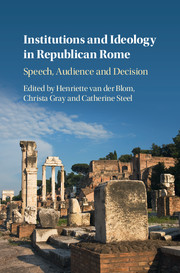Book contents
- Institutions and Ideology in Republican Rome
- Institutions and Ideology in Republican Rome
- Copyright page
- Dedication
- Contents
- Contributors
- Acknowledgements
- Abbreviations
- Introduction
- Part I Modes of Political Communication
- Part II Political Alliances
- Chapter 5 Political Alliances and Rivalries in Contiones in the Late Roman Republic
- Chapter 6 Theophanes of Mytilene, Cicero and Pompey’s Inner Circle
- Chapter 7 The Garden and the Forum
- Chapter 8 Cato, Pompey’s Third Consulship and the Politics of Milo’s Trial
- Part III Institutions in Theory and Practice
- Part IV Memory and Reputation
- Bibliography
- Index
Chapter 5 - Political Alliances and Rivalries in Contiones in the Late Roman Republic
from Part II - Political Alliances
Published online by Cambridge University Press: 08 May 2018
- Institutions and Ideology in Republican Rome
- Institutions and Ideology in Republican Rome
- Copyright page
- Dedication
- Contents
- Contributors
- Acknowledgements
- Abbreviations
- Introduction
- Part I Modes of Political Communication
- Part II Political Alliances
- Chapter 5 Political Alliances and Rivalries in Contiones in the Late Roman Republic
- Chapter 6 Theophanes of Mytilene, Cicero and Pompey’s Inner Circle
- Chapter 7 The Garden and the Forum
- Chapter 8 Cato, Pompey’s Third Consulship and the Politics of Milo’s Trial
- Part III Institutions in Theory and Practice
- Part IV Memory and Reputation
- Bibliography
- Index
Summary
- Type
- Chapter
- Information
- Institutions and Ideology in Republican RomeSpeech, Audience and Decision, pp. 107 - 127Publisher: Cambridge University PressPrint publication year: 2018

